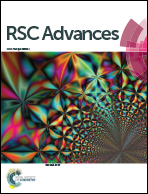Transition from rings to spots in a precipitation reaction–diffusion system†
Abstract
We report for the first time the transition from rings to spots with squared/hexagonal symmetry in a periodic precipitation system, which consists of sulfide/hydroxide ions diffusing into a gel matrix containing dissolved cadmium(II) ions. A phase diagram delineating the onset of the transition and the regions of various patterns is presented. The transition threshold, wavelength, and size of the resulting spots are shown to be controllable by adjusting the initial concentrations of the diffusing electrolytes. A scenario analogous to spinodal decomposition using the Cahn–Hilliard equation is shown to capture the experimental results.


 Please wait while we load your content...
Please wait while we load your content...